Environmental Sustainability in Construction: A Company Report
VerifiedAdded on 2020/03/28
|13
|3125
|51
Report
AI Summary
This report provides a comprehensive analysis of environmental sustainability in the construction industry, focusing on strategies and practices adopted by Express Ltd, a multinational construction company. The report delves into the significance of environmental sustainability, emphasizing its importance in mitigating the environmental impacts of construction projects while promoting resource efficiency and waste reduction. It explores key strategies such as the use of sustainable construction materials, energy-efficient practices, water conservation techniques, and waste management methodologies. The report also examines the company's organizational profile, reporting parameters, governance, commitments, and management approaches, illustrating a holistic view of environmental sustainability within the construction sector. It highlights the triple bottom line concept and the need for collaboration among stakeholders to achieve sustainable construction goals. The report concludes by emphasizing the crucial role of environmental sustainability in improving the quality of life for present and future generations, while acknowledging the challenges and issues associated with its implementation.
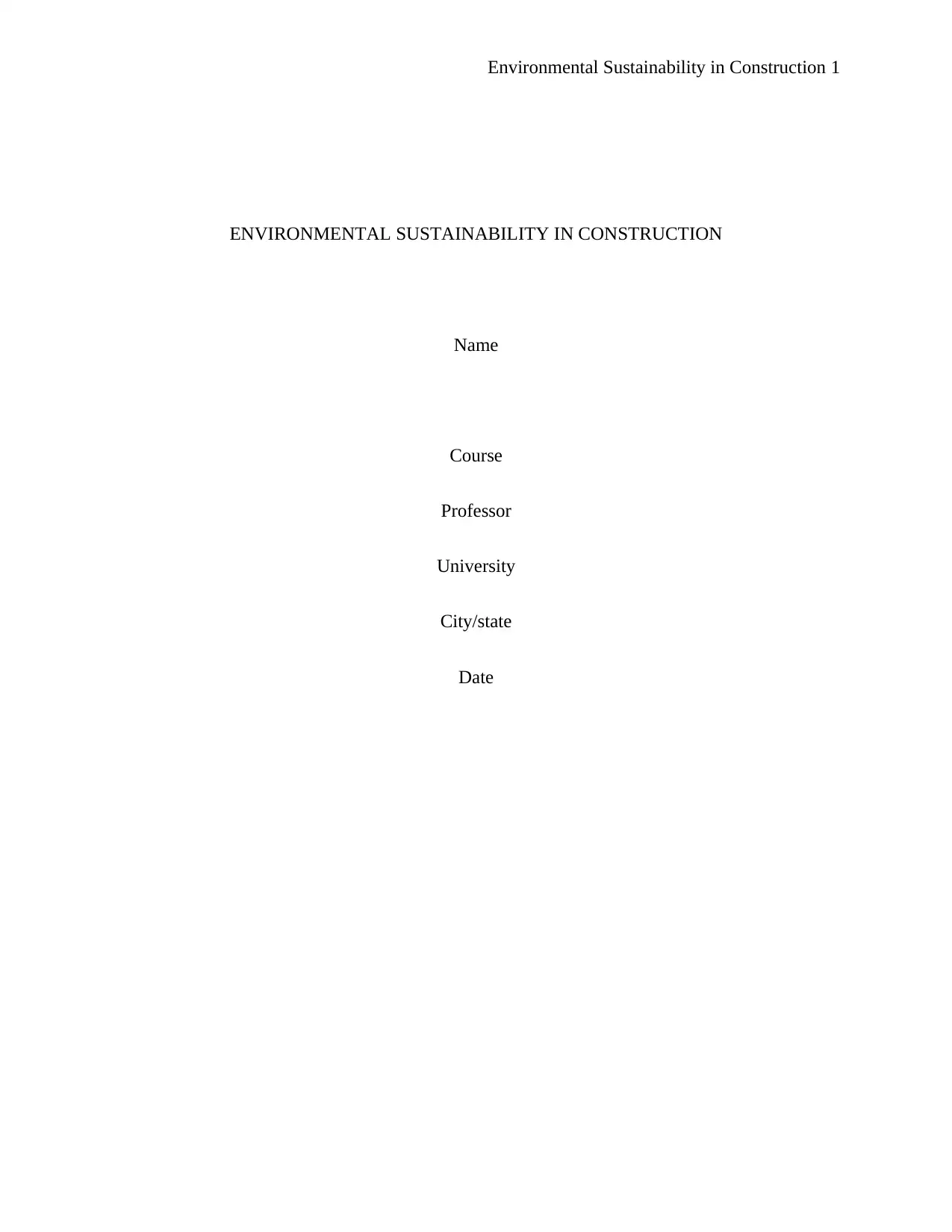
Environmental Sustainability in Construction 1
ENVIRONMENTAL SUSTAINABILITY IN CONSTRUCTION
Name
Course
Professor
University
City/state
Date
ENVIRONMENTAL SUSTAINABILITY IN CONSTRUCTION
Name
Course
Professor
University
City/state
Date
Paraphrase This Document
Need a fresh take? Get an instant paraphrase of this document with our AI Paraphraser
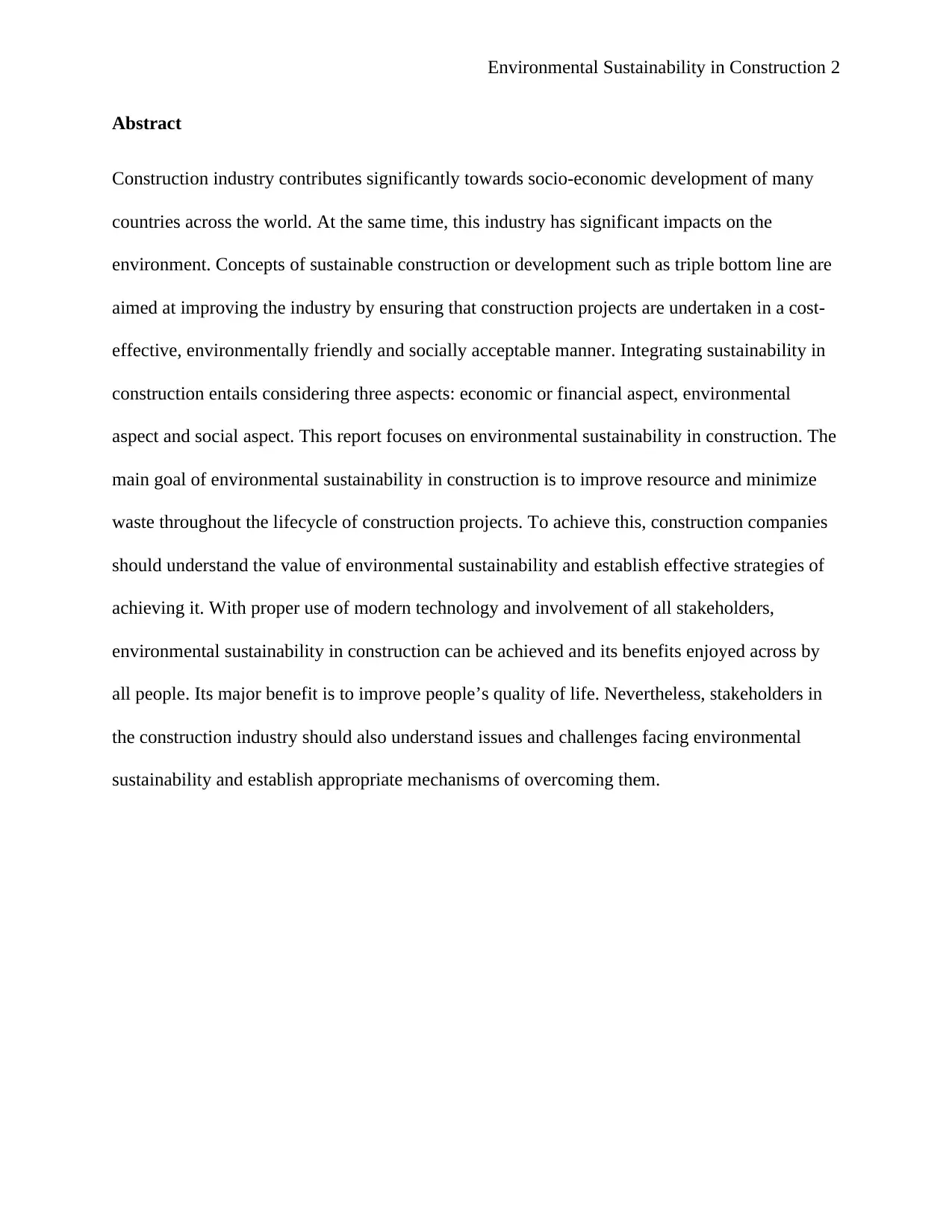
Environmental Sustainability in Construction 2
Abstract
Construction industry contributes significantly towards socio-economic development of many
countries across the world. At the same time, this industry has significant impacts on the
environment. Concepts of sustainable construction or development such as triple bottom line are
aimed at improving the industry by ensuring that construction projects are undertaken in a cost-
effective, environmentally friendly and socially acceptable manner. Integrating sustainability in
construction entails considering three aspects: economic or financial aspect, environmental
aspect and social aspect. This report focuses on environmental sustainability in construction. The
main goal of environmental sustainability in construction is to improve resource and minimize
waste throughout the lifecycle of construction projects. To achieve this, construction companies
should understand the value of environmental sustainability and establish effective strategies of
achieving it. With proper use of modern technology and involvement of all stakeholders,
environmental sustainability in construction can be achieved and its benefits enjoyed across by
all people. Its major benefit is to improve people’s quality of life. Nevertheless, stakeholders in
the construction industry should also understand issues and challenges facing environmental
sustainability and establish appropriate mechanisms of overcoming them.
Abstract
Construction industry contributes significantly towards socio-economic development of many
countries across the world. At the same time, this industry has significant impacts on the
environment. Concepts of sustainable construction or development such as triple bottom line are
aimed at improving the industry by ensuring that construction projects are undertaken in a cost-
effective, environmentally friendly and socially acceptable manner. Integrating sustainability in
construction entails considering three aspects: economic or financial aspect, environmental
aspect and social aspect. This report focuses on environmental sustainability in construction. The
main goal of environmental sustainability in construction is to improve resource and minimize
waste throughout the lifecycle of construction projects. To achieve this, construction companies
should understand the value of environmental sustainability and establish effective strategies of
achieving it. With proper use of modern technology and involvement of all stakeholders,
environmental sustainability in construction can be achieved and its benefits enjoyed across by
all people. Its major benefit is to improve people’s quality of life. Nevertheless, stakeholders in
the construction industry should also understand issues and challenges facing environmental
sustainability and establish appropriate mechanisms of overcoming them.

Environmental Sustainability in Construction 3
Table of Contents
1. Introduction.......................................................................................................................................4
2. Environmental sustainability report for the company....................................................................5
2.1. Introduction...........................................................................................................................5
2.2. Strategies and Analysis..............................................................................................................5
2.2.1. Construction materials.........................................................................................................5
2.2.2. Energy..................................................................................................................................6
2.2.3. Water...................................................................................................................................6
2.2.4. Waste...................................................................................................................................6
2.2.5. Innovation............................................................................................................................6
2.3. Organizational Profile...............................................................................................................7
2.4. Reporting parameters................................................................................................................8
2.5. Governance, commitments and engagement...........................................................................8
2.6. Management approach..............................................................................................................9
3. Discussion and Conclusion................................................................................................................9
References................................................................................................................................................11
Table of Contents
1. Introduction.......................................................................................................................................4
2. Environmental sustainability report for the company....................................................................5
2.1. Introduction...........................................................................................................................5
2.2. Strategies and Analysis..............................................................................................................5
2.2.1. Construction materials.........................................................................................................5
2.2.2. Energy..................................................................................................................................6
2.2.3. Water...................................................................................................................................6
2.2.4. Waste...................................................................................................................................6
2.2.5. Innovation............................................................................................................................6
2.3. Organizational Profile...............................................................................................................7
2.4. Reporting parameters................................................................................................................8
2.5. Governance, commitments and engagement...........................................................................8
2.6. Management approach..............................................................................................................9
3. Discussion and Conclusion................................................................................................................9
References................................................................................................................................................11
⊘ This is a preview!⊘
Do you want full access?
Subscribe today to unlock all pages.

Trusted by 1+ million students worldwide
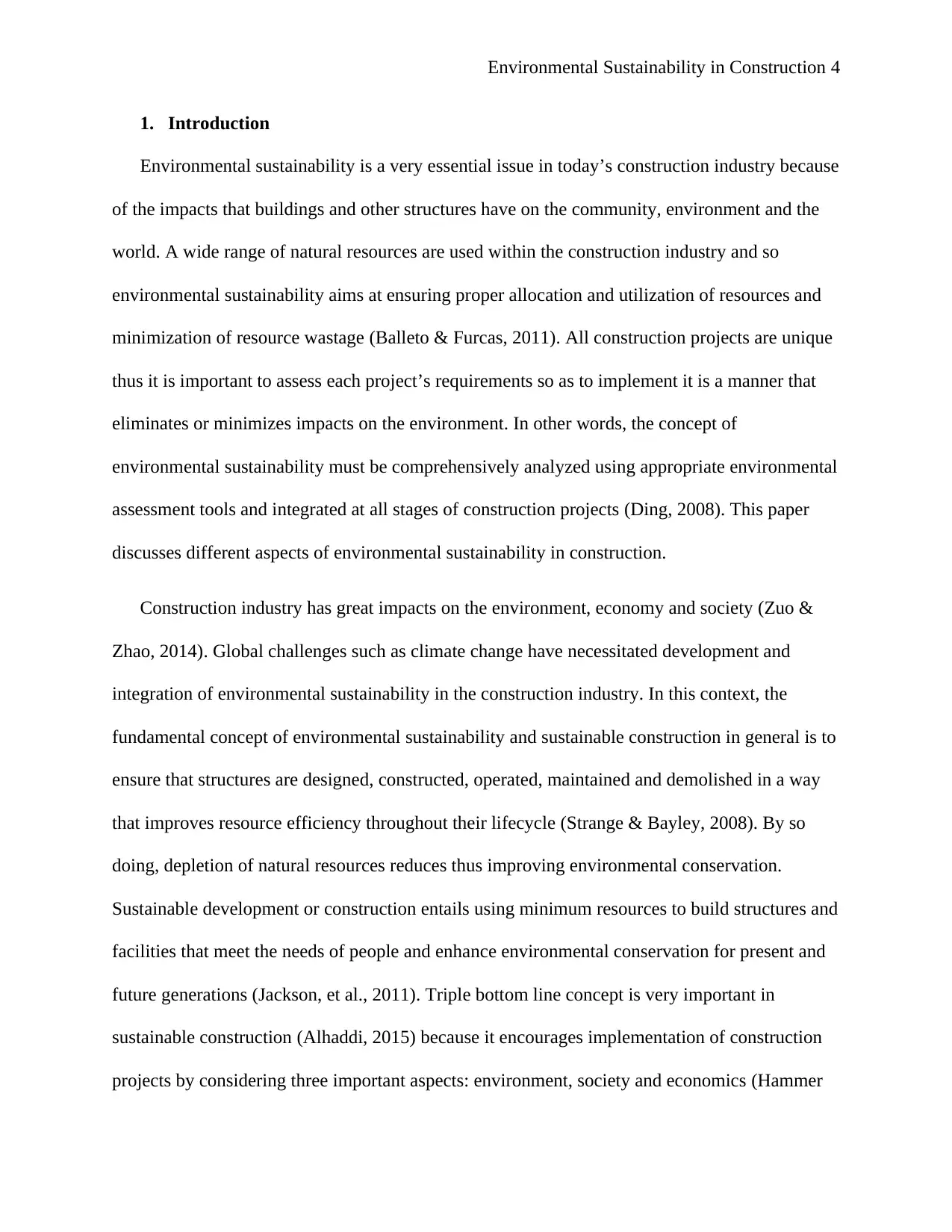
Environmental Sustainability in Construction 4
1. Introduction
Environmental sustainability is a very essential issue in today’s construction industry because
of the impacts that buildings and other structures have on the community, environment and the
world. A wide range of natural resources are used within the construction industry and so
environmental sustainability aims at ensuring proper allocation and utilization of resources and
minimization of resource wastage (Balleto & Furcas, 2011). All construction projects are unique
thus it is important to assess each project’s requirements so as to implement it is a manner that
eliminates or minimizes impacts on the environment. In other words, the concept of
environmental sustainability must be comprehensively analyzed using appropriate environmental
assessment tools and integrated at all stages of construction projects (Ding, 2008). This paper
discusses different aspects of environmental sustainability in construction.
Construction industry has great impacts on the environment, economy and society (Zuo &
Zhao, 2014). Global challenges such as climate change have necessitated development and
integration of environmental sustainability in the construction industry. In this context, the
fundamental concept of environmental sustainability and sustainable construction in general is to
ensure that structures are designed, constructed, operated, maintained and demolished in a way
that improves resource efficiency throughout their lifecycle (Strange & Bayley, 2008). By so
doing, depletion of natural resources reduces thus improving environmental conservation.
Sustainable development or construction entails using minimum resources to build structures and
facilities that meet the needs of people and enhance environmental conservation for present and
future generations (Jackson, et al., 2011). Triple bottom line concept is very important in
sustainable construction (Alhaddi, 2015) because it encourages implementation of construction
projects by considering three important aspects: environment, society and economics (Hammer
1. Introduction
Environmental sustainability is a very essential issue in today’s construction industry because
of the impacts that buildings and other structures have on the community, environment and the
world. A wide range of natural resources are used within the construction industry and so
environmental sustainability aims at ensuring proper allocation and utilization of resources and
minimization of resource wastage (Balleto & Furcas, 2011). All construction projects are unique
thus it is important to assess each project’s requirements so as to implement it is a manner that
eliminates or minimizes impacts on the environment. In other words, the concept of
environmental sustainability must be comprehensively analyzed using appropriate environmental
assessment tools and integrated at all stages of construction projects (Ding, 2008). This paper
discusses different aspects of environmental sustainability in construction.
Construction industry has great impacts on the environment, economy and society (Zuo &
Zhao, 2014). Global challenges such as climate change have necessitated development and
integration of environmental sustainability in the construction industry. In this context, the
fundamental concept of environmental sustainability and sustainable construction in general is to
ensure that structures are designed, constructed, operated, maintained and demolished in a way
that improves resource efficiency throughout their lifecycle (Strange & Bayley, 2008). By so
doing, depletion of natural resources reduces thus improving environmental conservation.
Sustainable development or construction entails using minimum resources to build structures and
facilities that meet the needs of people and enhance environmental conservation for present and
future generations (Jackson, et al., 2011). Triple bottom line concept is very important in
sustainable construction (Alhaddi, 2015) because it encourages implementation of construction
projects by considering three important aspects: environment, society and economics (Hammer
Paraphrase This Document
Need a fresh take? Get an instant paraphrase of this document with our AI Paraphraser

Environmental Sustainability in Construction 5
& Pivo, 2016). In other words, this concept ensures that companies undertake construction
projects by considering their financial, environmental and social impacts. As a result of this,
projects are undertaken in an environmentally friendly, financially viable (cost-effective) and
socially acceptable manner (Lederwasch & Mukheibir, 2013).
2. Environmental sustainability report for the company
2.1. Introduction
Express Ltd is a multinational construction company located in Sydney, Australia. The
company was established in 1987 and has undertaken various projects in more than 30 countries
including Australia, China, U.S., Canada, Italy, Germany, France, England and Abu Dhabi,
among others. The company focusses on design and construction of buildings, roads, railways,
dams, irrigation systems, water supply and drainage systems, pipelines and stadiums. The
company has an environmental policy to show its commitment of being environmentally
responsible. Express Ltd employs around 25,000 people worldwide and manages projects worth
about $40 billion annually. The company has a sound financial base and its annual revenue is
about $25 billion.
2.2. Strategies and Analysis
Express Ltd takes environmentally sustainability very seriously and has received several
recognitions and awards for the same efforts. The company uses several strategies to achieve its
environmental sustainability goals. Key of these strategies are provided below
2.2.1. Construction materials
The company uses construction materials selected based on an environmental
sustainability criteria. The company uses locally available and recycled materials through
& Pivo, 2016). In other words, this concept ensures that companies undertake construction
projects by considering their financial, environmental and social impacts. As a result of this,
projects are undertaken in an environmentally friendly, financially viable (cost-effective) and
socially acceptable manner (Lederwasch & Mukheibir, 2013).
2. Environmental sustainability report for the company
2.1. Introduction
Express Ltd is a multinational construction company located in Sydney, Australia. The
company was established in 1987 and has undertaken various projects in more than 30 countries
including Australia, China, U.S., Canada, Italy, Germany, France, England and Abu Dhabi,
among others. The company focusses on design and construction of buildings, roads, railways,
dams, irrigation systems, water supply and drainage systems, pipelines and stadiums. The
company has an environmental policy to show its commitment of being environmentally
responsible. Express Ltd employs around 25,000 people worldwide and manages projects worth
about $40 billion annually. The company has a sound financial base and its annual revenue is
about $25 billion.
2.2. Strategies and Analysis
Express Ltd takes environmentally sustainability very seriously and has received several
recognitions and awards for the same efforts. The company uses several strategies to achieve its
environmental sustainability goals. Key of these strategies are provided below
2.2.1. Construction materials
The company uses construction materials selected based on an environmental
sustainability criteria. The company uses locally available and recycled materials through
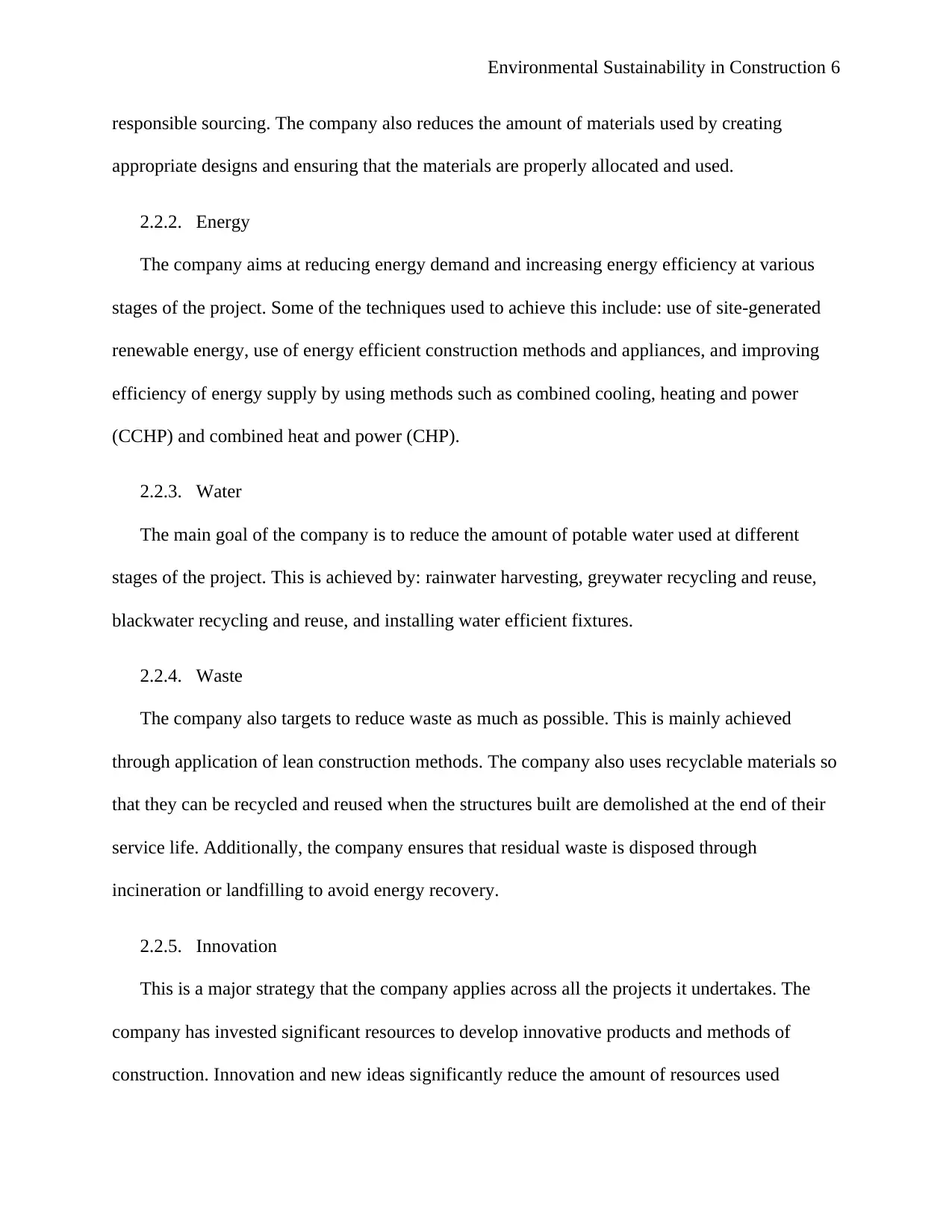
Environmental Sustainability in Construction 6
responsible sourcing. The company also reduces the amount of materials used by creating
appropriate designs and ensuring that the materials are properly allocated and used.
2.2.2. Energy
The company aims at reducing energy demand and increasing energy efficiency at various
stages of the project. Some of the techniques used to achieve this include: use of site-generated
renewable energy, use of energy efficient construction methods and appliances, and improving
efficiency of energy supply by using methods such as combined cooling, heating and power
(CCHP) and combined heat and power (CHP).
2.2.3. Water
The main goal of the company is to reduce the amount of potable water used at different
stages of the project. This is achieved by: rainwater harvesting, greywater recycling and reuse,
blackwater recycling and reuse, and installing water efficient fixtures.
2.2.4. Waste
The company also targets to reduce waste as much as possible. This is mainly achieved
through application of lean construction methods. The company also uses recyclable materials so
that they can be recycled and reused when the structures built are demolished at the end of their
service life. Additionally, the company ensures that residual waste is disposed through
incineration or landfilling to avoid energy recovery.
2.2.5. Innovation
This is a major strategy that the company applies across all the projects it undertakes. The
company has invested significant resources to develop innovative products and methods of
construction. Innovation and new ideas significantly reduce the amount of resources used
responsible sourcing. The company also reduces the amount of materials used by creating
appropriate designs and ensuring that the materials are properly allocated and used.
2.2.2. Energy
The company aims at reducing energy demand and increasing energy efficiency at various
stages of the project. Some of the techniques used to achieve this include: use of site-generated
renewable energy, use of energy efficient construction methods and appliances, and improving
efficiency of energy supply by using methods such as combined cooling, heating and power
(CCHP) and combined heat and power (CHP).
2.2.3. Water
The main goal of the company is to reduce the amount of potable water used at different
stages of the project. This is achieved by: rainwater harvesting, greywater recycling and reuse,
blackwater recycling and reuse, and installing water efficient fixtures.
2.2.4. Waste
The company also targets to reduce waste as much as possible. This is mainly achieved
through application of lean construction methods. The company also uses recyclable materials so
that they can be recycled and reused when the structures built are demolished at the end of their
service life. Additionally, the company ensures that residual waste is disposed through
incineration or landfilling to avoid energy recovery.
2.2.5. Innovation
This is a major strategy that the company applies across all the projects it undertakes. The
company has invested significant resources to develop innovative products and methods of
construction. Innovation and new ideas significantly reduce the amount of resources used
⊘ This is a preview!⊘
Do you want full access?
Subscribe today to unlock all pages.

Trusted by 1+ million students worldwide
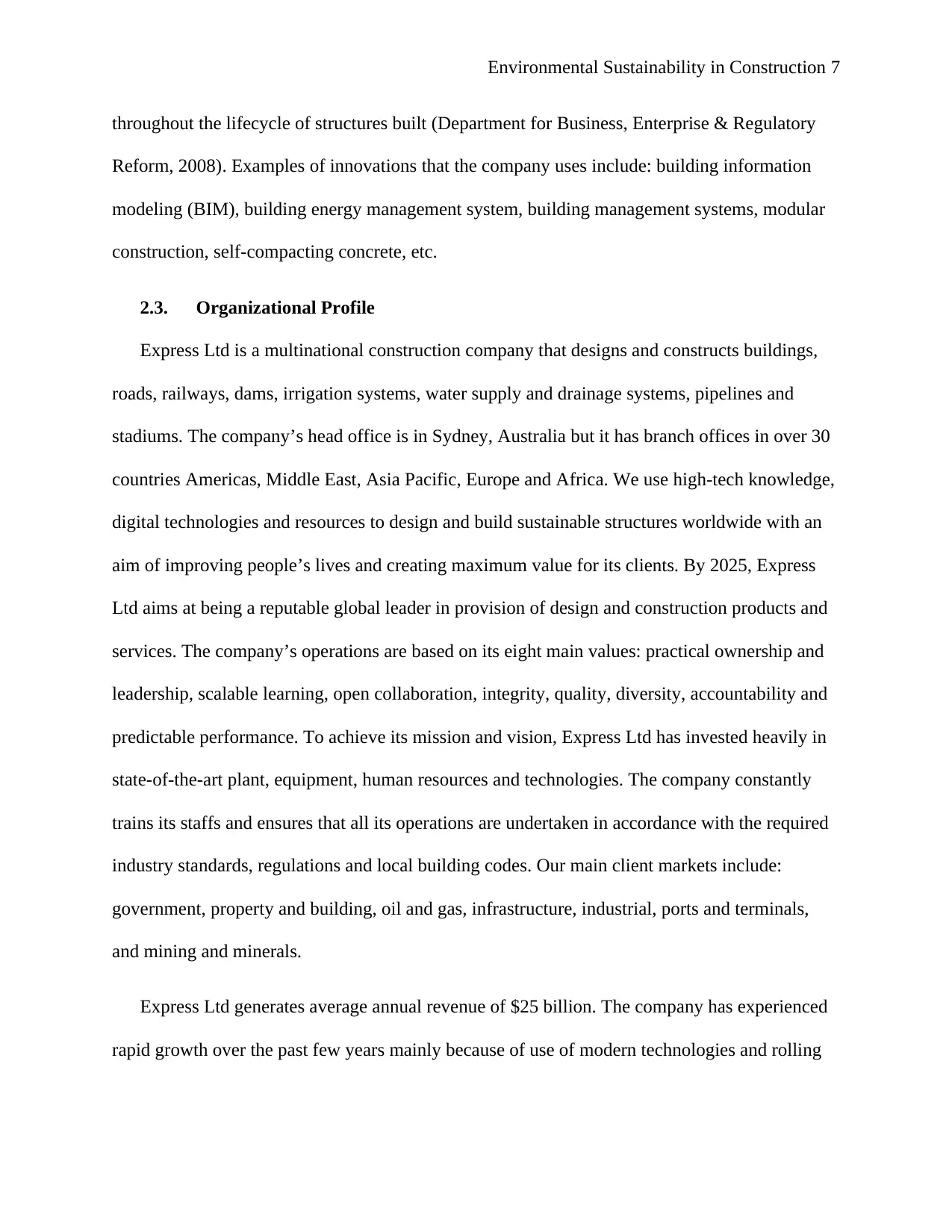
Environmental Sustainability in Construction 7
throughout the lifecycle of structures built (Department for Business, Enterprise & Regulatory
Reform, 2008). Examples of innovations that the company uses include: building information
modeling (BIM), building energy management system, building management systems, modular
construction, self-compacting concrete, etc.
2.3. Organizational Profile
Express Ltd is a multinational construction company that designs and constructs buildings,
roads, railways, dams, irrigation systems, water supply and drainage systems, pipelines and
stadiums. The company’s head office is in Sydney, Australia but it has branch offices in over 30
countries Americas, Middle East, Asia Pacific, Europe and Africa. We use high-tech knowledge,
digital technologies and resources to design and build sustainable structures worldwide with an
aim of improving people’s lives and creating maximum value for its clients. By 2025, Express
Ltd aims at being a reputable global leader in provision of design and construction products and
services. The company’s operations are based on its eight main values: practical ownership and
leadership, scalable learning, open collaboration, integrity, quality, diversity, accountability and
predictable performance. To achieve its mission and vision, Express Ltd has invested heavily in
state-of-the-art plant, equipment, human resources and technologies. The company constantly
trains its staffs and ensures that all its operations are undertaken in accordance with the required
industry standards, regulations and local building codes. Our main client markets include:
government, property and building, oil and gas, infrastructure, industrial, ports and terminals,
and mining and minerals.
Express Ltd generates average annual revenue of $25 billion. The company has experienced
rapid growth over the past few years mainly because of use of modern technologies and rolling
throughout the lifecycle of structures built (Department for Business, Enterprise & Regulatory
Reform, 2008). Examples of innovations that the company uses include: building information
modeling (BIM), building energy management system, building management systems, modular
construction, self-compacting concrete, etc.
2.3. Organizational Profile
Express Ltd is a multinational construction company that designs and constructs buildings,
roads, railways, dams, irrigation systems, water supply and drainage systems, pipelines and
stadiums. The company’s head office is in Sydney, Australia but it has branch offices in over 30
countries Americas, Middle East, Asia Pacific, Europe and Africa. We use high-tech knowledge,
digital technologies and resources to design and build sustainable structures worldwide with an
aim of improving people’s lives and creating maximum value for its clients. By 2025, Express
Ltd aims at being a reputable global leader in provision of design and construction products and
services. The company’s operations are based on its eight main values: practical ownership and
leadership, scalable learning, open collaboration, integrity, quality, diversity, accountability and
predictable performance. To achieve its mission and vision, Express Ltd has invested heavily in
state-of-the-art plant, equipment, human resources and technologies. The company constantly
trains its staffs and ensures that all its operations are undertaken in accordance with the required
industry standards, regulations and local building codes. Our main client markets include:
government, property and building, oil and gas, infrastructure, industrial, ports and terminals,
and mining and minerals.
Express Ltd generates average annual revenue of $25 billion. The company has experienced
rapid growth over the past few years mainly because of use of modern technologies and rolling
Paraphrase This Document
Need a fresh take? Get an instant paraphrase of this document with our AI Paraphraser
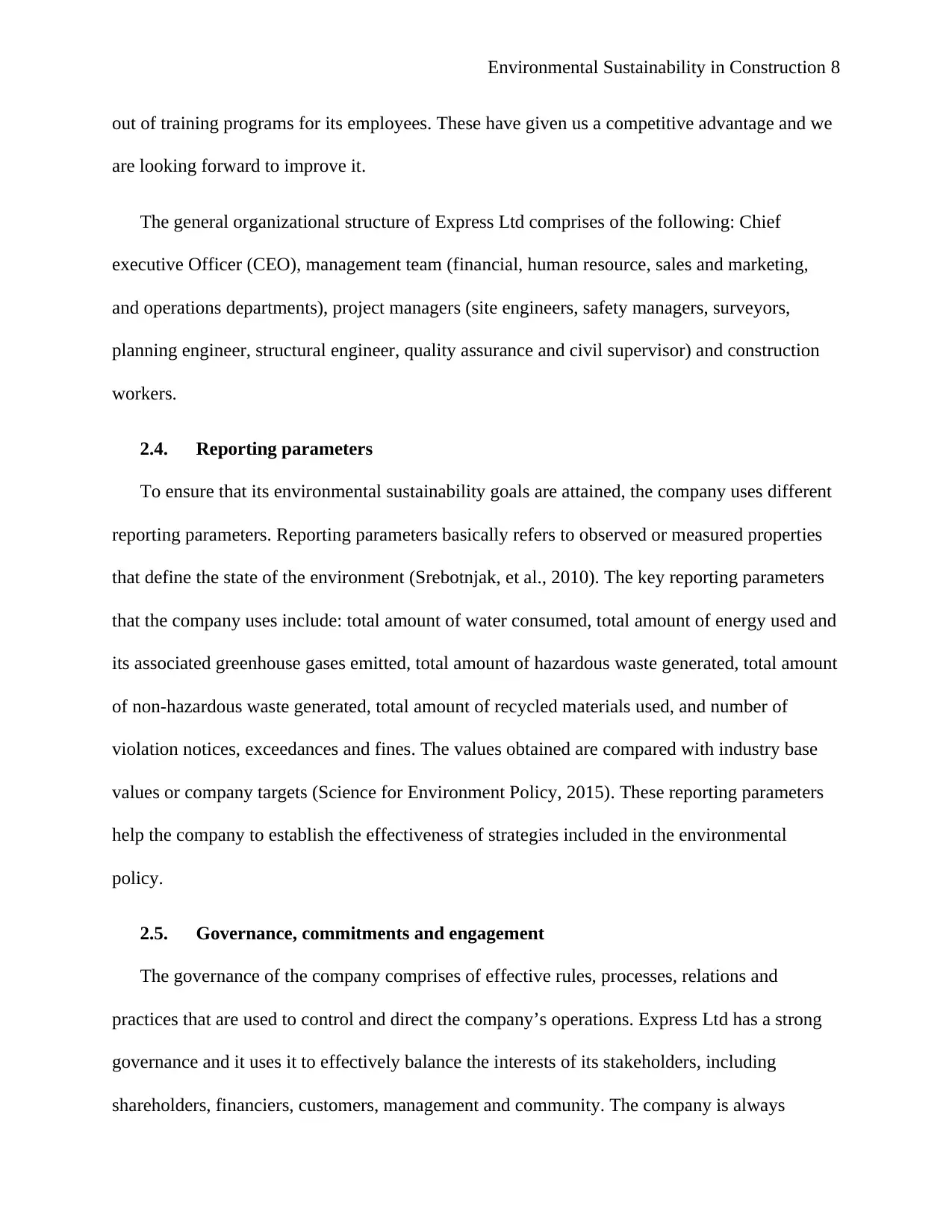
Environmental Sustainability in Construction 8
out of training programs for its employees. These have given us a competitive advantage and we
are looking forward to improve it.
The general organizational structure of Express Ltd comprises of the following: Chief
executive Officer (CEO), management team (financial, human resource, sales and marketing,
and operations departments), project managers (site engineers, safety managers, surveyors,
planning engineer, structural engineer, quality assurance and civil supervisor) and construction
workers.
2.4. Reporting parameters
To ensure that its environmental sustainability goals are attained, the company uses different
reporting parameters. Reporting parameters basically refers to observed or measured properties
that define the state of the environment (Srebotnjak, et al., 2010). The key reporting parameters
that the company uses include: total amount of water consumed, total amount of energy used and
its associated greenhouse gases emitted, total amount of hazardous waste generated, total amount
of non-hazardous waste generated, total amount of recycled materials used, and number of
violation notices, exceedances and fines. The values obtained are compared with industry base
values or company targets (Science for Environment Policy, 2015). These reporting parameters
help the company to establish the effectiveness of strategies included in the environmental
policy.
2.5. Governance, commitments and engagement
The governance of the company comprises of effective rules, processes, relations and
practices that are used to control and direct the company’s operations. Express Ltd has a strong
governance and it uses it to effectively balance the interests of its stakeholders, including
shareholders, financiers, customers, management and community. The company is always
out of training programs for its employees. These have given us a competitive advantage and we
are looking forward to improve it.
The general organizational structure of Express Ltd comprises of the following: Chief
executive Officer (CEO), management team (financial, human resource, sales and marketing,
and operations departments), project managers (site engineers, safety managers, surveyors,
planning engineer, structural engineer, quality assurance and civil supervisor) and construction
workers.
2.4. Reporting parameters
To ensure that its environmental sustainability goals are attained, the company uses different
reporting parameters. Reporting parameters basically refers to observed or measured properties
that define the state of the environment (Srebotnjak, et al., 2010). The key reporting parameters
that the company uses include: total amount of water consumed, total amount of energy used and
its associated greenhouse gases emitted, total amount of hazardous waste generated, total amount
of non-hazardous waste generated, total amount of recycled materials used, and number of
violation notices, exceedances and fines. The values obtained are compared with industry base
values or company targets (Science for Environment Policy, 2015). These reporting parameters
help the company to establish the effectiveness of strategies included in the environmental
policy.
2.5. Governance, commitments and engagement
The governance of the company comprises of effective rules, processes, relations and
practices that are used to control and direct the company’s operations. Express Ltd has a strong
governance and it uses it to effectively balance the interests of its stakeholders, including
shareholders, financiers, customers, management and community. The company is always
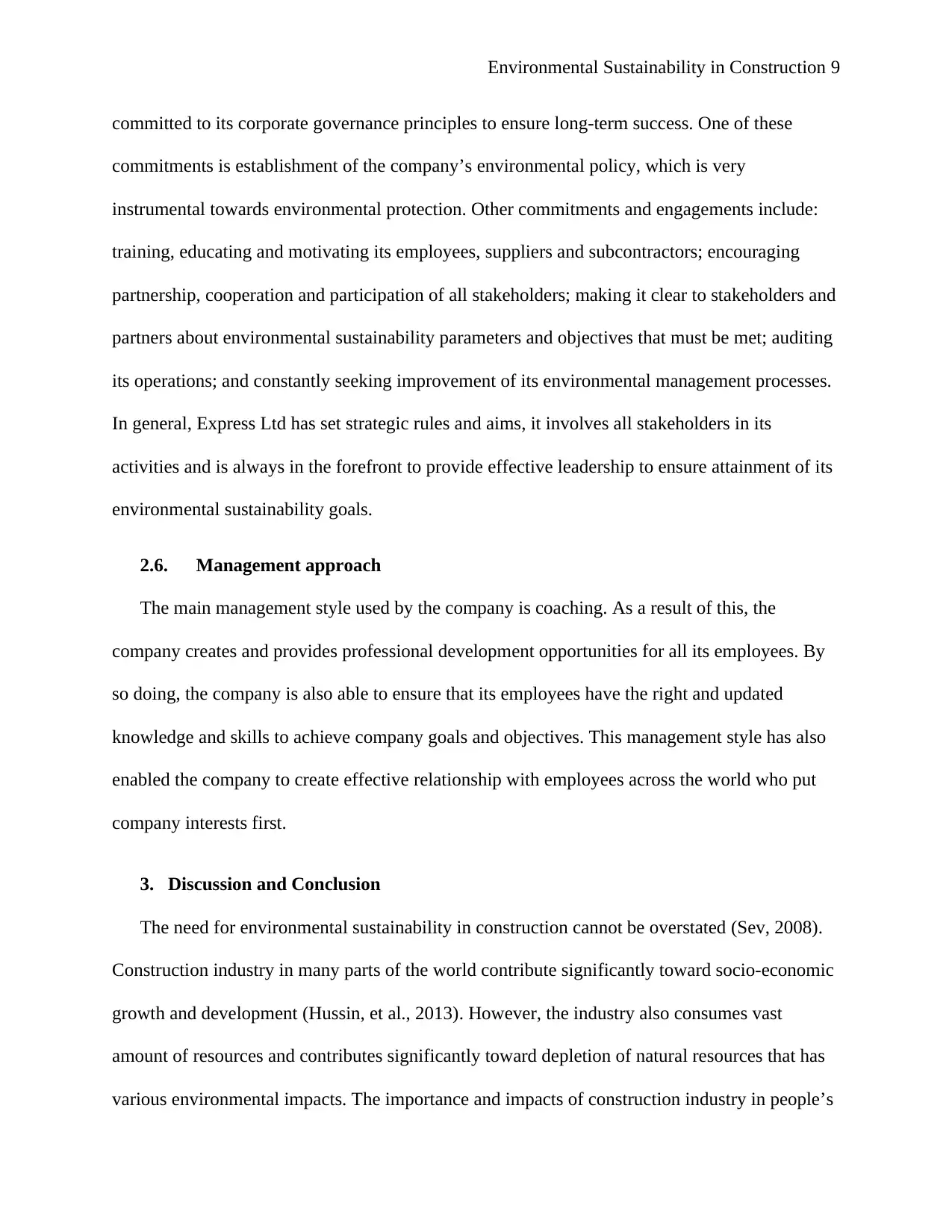
Environmental Sustainability in Construction 9
committed to its corporate governance principles to ensure long-term success. One of these
commitments is establishment of the company’s environmental policy, which is very
instrumental towards environmental protection. Other commitments and engagements include:
training, educating and motivating its employees, suppliers and subcontractors; encouraging
partnership, cooperation and participation of all stakeholders; making it clear to stakeholders and
partners about environmental sustainability parameters and objectives that must be met; auditing
its operations; and constantly seeking improvement of its environmental management processes.
In general, Express Ltd has set strategic rules and aims, it involves all stakeholders in its
activities and is always in the forefront to provide effective leadership to ensure attainment of its
environmental sustainability goals.
2.6. Management approach
The main management style used by the company is coaching. As a result of this, the
company creates and provides professional development opportunities for all its employees. By
so doing, the company is also able to ensure that its employees have the right and updated
knowledge and skills to achieve company goals and objectives. This management style has also
enabled the company to create effective relationship with employees across the world who put
company interests first.
3. Discussion and Conclusion
The need for environmental sustainability in construction cannot be overstated (Sev, 2008).
Construction industry in many parts of the world contribute significantly toward socio-economic
growth and development (Hussin, et al., 2013). However, the industry also consumes vast
amount of resources and contributes significantly toward depletion of natural resources that has
various environmental impacts. The importance and impacts of construction industry in people’s
committed to its corporate governance principles to ensure long-term success. One of these
commitments is establishment of the company’s environmental policy, which is very
instrumental towards environmental protection. Other commitments and engagements include:
training, educating and motivating its employees, suppliers and subcontractors; encouraging
partnership, cooperation and participation of all stakeholders; making it clear to stakeholders and
partners about environmental sustainability parameters and objectives that must be met; auditing
its operations; and constantly seeking improvement of its environmental management processes.
In general, Express Ltd has set strategic rules and aims, it involves all stakeholders in its
activities and is always in the forefront to provide effective leadership to ensure attainment of its
environmental sustainability goals.
2.6. Management approach
The main management style used by the company is coaching. As a result of this, the
company creates and provides professional development opportunities for all its employees. By
so doing, the company is also able to ensure that its employees have the right and updated
knowledge and skills to achieve company goals and objectives. This management style has also
enabled the company to create effective relationship with employees across the world who put
company interests first.
3. Discussion and Conclusion
The need for environmental sustainability in construction cannot be overstated (Sev, 2008).
Construction industry in many parts of the world contribute significantly toward socio-economic
growth and development (Hussin, et al., 2013). However, the industry also consumes vast
amount of resources and contributes significantly toward depletion of natural resources that has
various environmental impacts. The importance and impacts of construction industry in people’s
⊘ This is a preview!⊘
Do you want full access?
Subscribe today to unlock all pages.

Trusted by 1+ million students worldwide
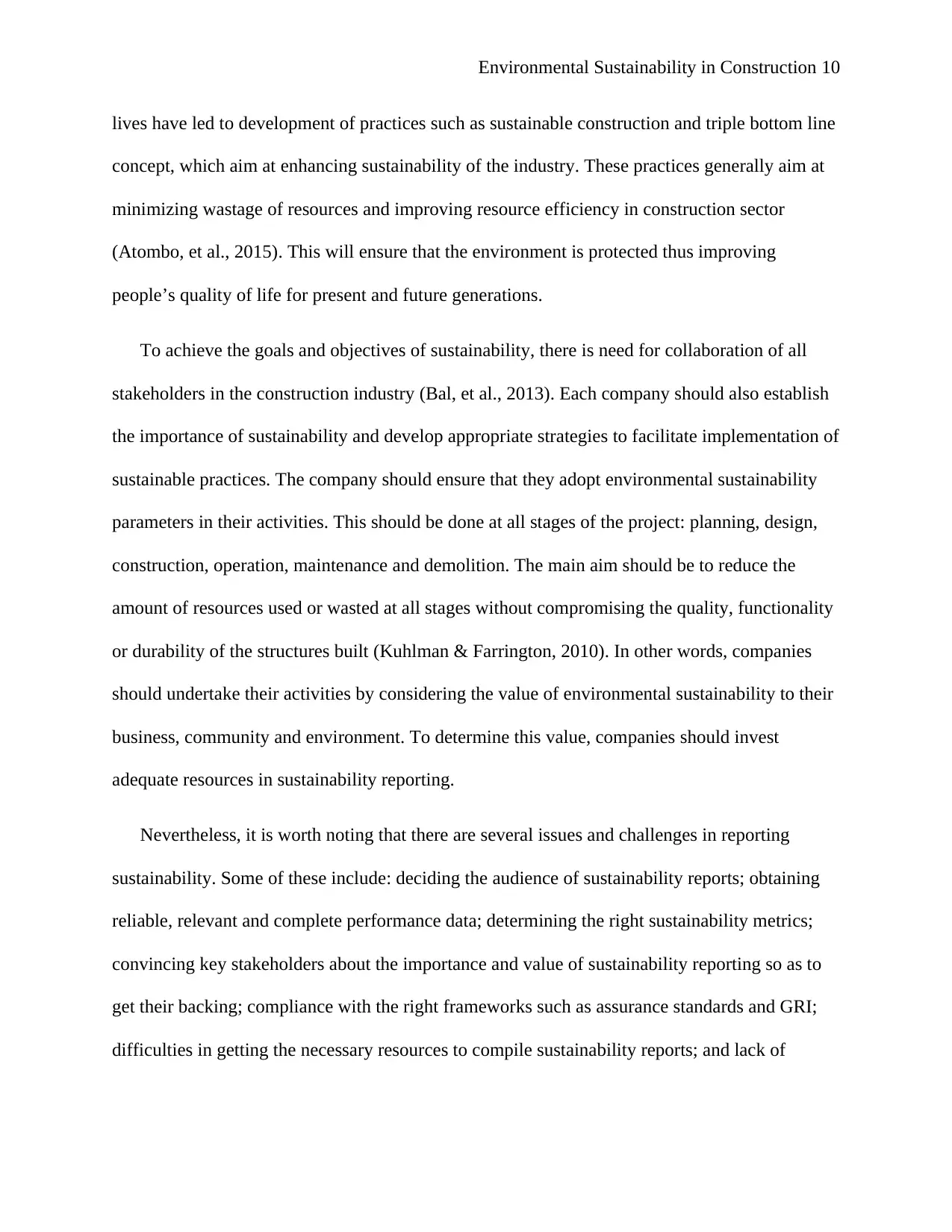
Environmental Sustainability in Construction 10
lives have led to development of practices such as sustainable construction and triple bottom line
concept, which aim at enhancing sustainability of the industry. These practices generally aim at
minimizing wastage of resources and improving resource efficiency in construction sector
(Atombo, et al., 2015). This will ensure that the environment is protected thus improving
people’s quality of life for present and future generations.
To achieve the goals and objectives of sustainability, there is need for collaboration of all
stakeholders in the construction industry (Bal, et al., 2013). Each company should also establish
the importance of sustainability and develop appropriate strategies to facilitate implementation of
sustainable practices. The company should ensure that they adopt environmental sustainability
parameters in their activities. This should be done at all stages of the project: planning, design,
construction, operation, maintenance and demolition. The main aim should be to reduce the
amount of resources used or wasted at all stages without compromising the quality, functionality
or durability of the structures built (Kuhlman & Farrington, 2010). In other words, companies
should undertake their activities by considering the value of environmental sustainability to their
business, community and environment. To determine this value, companies should invest
adequate resources in sustainability reporting.
Nevertheless, it is worth noting that there are several issues and challenges in reporting
sustainability. Some of these include: deciding the audience of sustainability reports; obtaining
reliable, relevant and complete performance data; determining the right sustainability metrics;
convincing key stakeholders about the importance and value of sustainability reporting so as to
get their backing; compliance with the right frameworks such as assurance standards and GRI;
difficulties in getting the necessary resources to compile sustainability reports; and lack of
lives have led to development of practices such as sustainable construction and triple bottom line
concept, which aim at enhancing sustainability of the industry. These practices generally aim at
minimizing wastage of resources and improving resource efficiency in construction sector
(Atombo, et al., 2015). This will ensure that the environment is protected thus improving
people’s quality of life for present and future generations.
To achieve the goals and objectives of sustainability, there is need for collaboration of all
stakeholders in the construction industry (Bal, et al., 2013). Each company should also establish
the importance of sustainability and develop appropriate strategies to facilitate implementation of
sustainable practices. The company should ensure that they adopt environmental sustainability
parameters in their activities. This should be done at all stages of the project: planning, design,
construction, operation, maintenance and demolition. The main aim should be to reduce the
amount of resources used or wasted at all stages without compromising the quality, functionality
or durability of the structures built (Kuhlman & Farrington, 2010). In other words, companies
should undertake their activities by considering the value of environmental sustainability to their
business, community and environment. To determine this value, companies should invest
adequate resources in sustainability reporting.
Nevertheless, it is worth noting that there are several issues and challenges in reporting
sustainability. Some of these include: deciding the audience of sustainability reports; obtaining
reliable, relevant and complete performance data; determining the right sustainability metrics;
convincing key stakeholders about the importance and value of sustainability reporting so as to
get their backing; compliance with the right frameworks such as assurance standards and GRI;
difficulties in getting the necessary resources to compile sustainability reports; and lack of
Paraphrase This Document
Need a fresh take? Get an instant paraphrase of this document with our AI Paraphraser
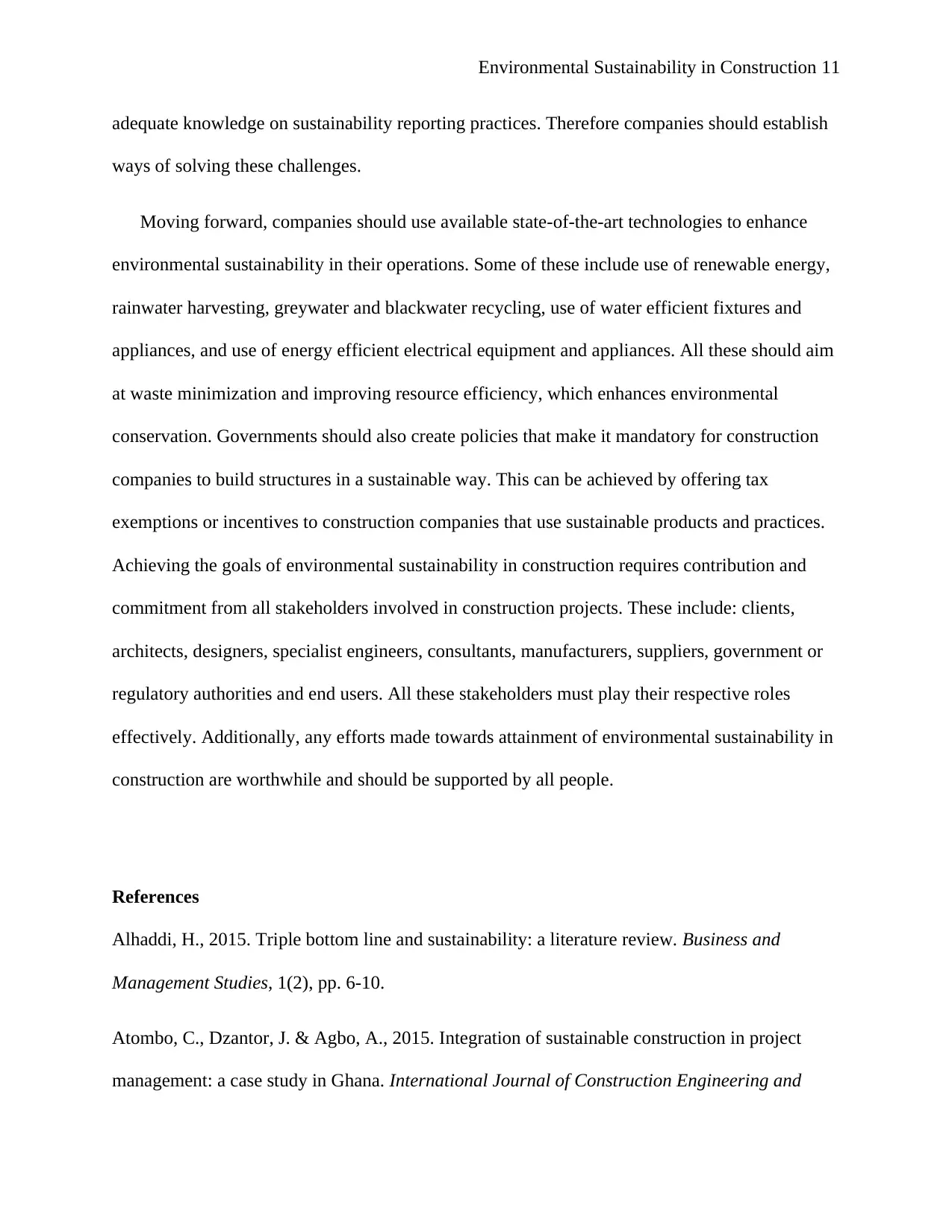
Environmental Sustainability in Construction 11
adequate knowledge on sustainability reporting practices. Therefore companies should establish
ways of solving these challenges.
Moving forward, companies should use available state-of-the-art technologies to enhance
environmental sustainability in their operations. Some of these include use of renewable energy,
rainwater harvesting, greywater and blackwater recycling, use of water efficient fixtures and
appliances, and use of energy efficient electrical equipment and appliances. All these should aim
at waste minimization and improving resource efficiency, which enhances environmental
conservation. Governments should also create policies that make it mandatory for construction
companies to build structures in a sustainable way. This can be achieved by offering tax
exemptions or incentives to construction companies that use sustainable products and practices.
Achieving the goals of environmental sustainability in construction requires contribution and
commitment from all stakeholders involved in construction projects. These include: clients,
architects, designers, specialist engineers, consultants, manufacturers, suppliers, government or
regulatory authorities and end users. All these stakeholders must play their respective roles
effectively. Additionally, any efforts made towards attainment of environmental sustainability in
construction are worthwhile and should be supported by all people.
References
Alhaddi, H., 2015. Triple bottom line and sustainability: a literature review. Business and
Management Studies, 1(2), pp. 6-10.
Atombo, C., Dzantor, J. & Agbo, A., 2015. Integration of sustainable construction in project
management: a case study in Ghana. International Journal of Construction Engineering and
adequate knowledge on sustainability reporting practices. Therefore companies should establish
ways of solving these challenges.
Moving forward, companies should use available state-of-the-art technologies to enhance
environmental sustainability in their operations. Some of these include use of renewable energy,
rainwater harvesting, greywater and blackwater recycling, use of water efficient fixtures and
appliances, and use of energy efficient electrical equipment and appliances. All these should aim
at waste minimization and improving resource efficiency, which enhances environmental
conservation. Governments should also create policies that make it mandatory for construction
companies to build structures in a sustainable way. This can be achieved by offering tax
exemptions or incentives to construction companies that use sustainable products and practices.
Achieving the goals of environmental sustainability in construction requires contribution and
commitment from all stakeholders involved in construction projects. These include: clients,
architects, designers, specialist engineers, consultants, manufacturers, suppliers, government or
regulatory authorities and end users. All these stakeholders must play their respective roles
effectively. Additionally, any efforts made towards attainment of environmental sustainability in
construction are worthwhile and should be supported by all people.
References
Alhaddi, H., 2015. Triple bottom line and sustainability: a literature review. Business and
Management Studies, 1(2), pp. 6-10.
Atombo, C., Dzantor, J. & Agbo, A., 2015. Integration of sustainable construction in project
management: a case study in Ghana. International Journal of Construction Engineering and

Environmental Sustainability in Construction 12
Management, 4(1), pp. 13-25.
Balleto, G. & Furcas, C., 2011. Environmental sustainability in the construction industry related
to the production of aggregates qualitative aspects, case studies and future outlooks.
International Journal of Environmental Science and Development, 2(2), pp. 109-115.
Bal, M., Bryde, D., Fearon, D. & Ochieng, E., 2013. Stakeholder engagement: achieving
sustainability in the construction sector. Sustainability, Volume 6, pp. 695-710.
Department for Business, Enterprise & Regulatory Reform, 2008. Strategy for sustainable
construction, London: Department for Business, Enterprise & Regulatory Reform.
Ding, G., 2008. Sustainable construction - the role of environmental assessment tools. Journal of
Environmental Management, 86(3), pp. 451-464.
Hammer, J. & Pivo, G., 2016. The triple bottom line and sustainable economic development
theory and practice, California, U.S. : SAGE Publications.
Hussin, J., Rahman, I. & Memon, A., 2013. The way forward in sustainable construction: issues
and challenges. International Journal of Advances in Applied Science (IJAAS), 2(1), pp. 15-24.
Jackson, A., Boswell, K. & Davis, D., 2011. Sustainability and triple bottom line reporting -
what is it all about?. International Journal of Business, Humanities and Technology, 1(3), pp.
55-59.
Kuhlman, T. & Farrington, J., 2010. What is sustainability?. Sustainability, Volume 2, pp. 3436-
3448.
Lederwasch, A. & Mukheibir, P., 2013. The triple bottom line and progress towards ecological
sustainable development: Australia's coal mining industry as a case study. Resources, Volume 2,
Management, 4(1), pp. 13-25.
Balleto, G. & Furcas, C., 2011. Environmental sustainability in the construction industry related
to the production of aggregates qualitative aspects, case studies and future outlooks.
International Journal of Environmental Science and Development, 2(2), pp. 109-115.
Bal, M., Bryde, D., Fearon, D. & Ochieng, E., 2013. Stakeholder engagement: achieving
sustainability in the construction sector. Sustainability, Volume 6, pp. 695-710.
Department for Business, Enterprise & Regulatory Reform, 2008. Strategy for sustainable
construction, London: Department for Business, Enterprise & Regulatory Reform.
Ding, G., 2008. Sustainable construction - the role of environmental assessment tools. Journal of
Environmental Management, 86(3), pp. 451-464.
Hammer, J. & Pivo, G., 2016. The triple bottom line and sustainable economic development
theory and practice, California, U.S. : SAGE Publications.
Hussin, J., Rahman, I. & Memon, A., 2013. The way forward in sustainable construction: issues
and challenges. International Journal of Advances in Applied Science (IJAAS), 2(1), pp. 15-24.
Jackson, A., Boswell, K. & Davis, D., 2011. Sustainability and triple bottom line reporting -
what is it all about?. International Journal of Business, Humanities and Technology, 1(3), pp.
55-59.
Kuhlman, T. & Farrington, J., 2010. What is sustainability?. Sustainability, Volume 2, pp. 3436-
3448.
Lederwasch, A. & Mukheibir, P., 2013. The triple bottom line and progress towards ecological
sustainable development: Australia's coal mining industry as a case study. Resources, Volume 2,
⊘ This is a preview!⊘
Do you want full access?
Subscribe today to unlock all pages.

Trusted by 1+ million students worldwide
1 out of 13
Related Documents
Your All-in-One AI-Powered Toolkit for Academic Success.
+13062052269
info@desklib.com
Available 24*7 on WhatsApp / Email
![[object Object]](/_next/static/media/star-bottom.7253800d.svg)
Unlock your academic potential
Copyright © 2020–2025 A2Z Services. All Rights Reserved. Developed and managed by ZUCOL.





